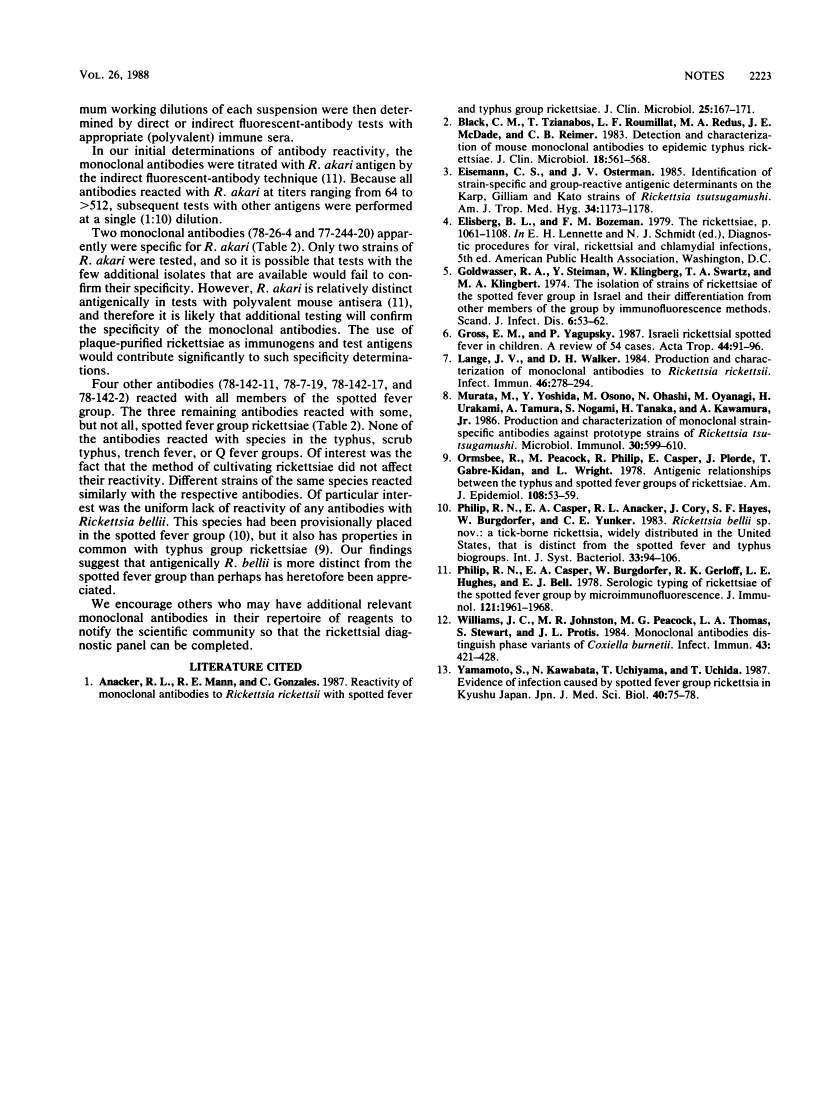Abstract
Free full text

Addition of monoclonal antibodies specific for Rickettsia akari to the rickettsial diagnostic panel.
Abstract
Monoclonal antibodies were produced from mice infected with Rickettsia akari (the etiologic agent of rickettsialpox) and evaluated for specificity in indirect fluorescent-antibody tests with 23 different rickettsial antigens. Of the nine antibodies that were evaluated, two were specific for R. akari and four reacted with R. akari and all other spotted fever group rickettsiae. The remaining three antibodies reacted with some, but not all, members of the spotted fever group. None of the antibodies reacted with typhus, scrub typhus, trench fever, or Q fever rickettsiae. Adding these antibodies to the list of available diagnostic reagents will facilitate identification of rickettsial diseases, particularly those caused by members of the spotted fever group, where the clinical presentations are similar and the etiologic agents are closely related antigenically.
Full text
Full text is available as a scanned copy of the original print version. Get a printable copy (PDF file) of the complete article (474K), or click on a page image below to browse page by page. Links to PubMed are also available for Selected References.
Selected References
These references are in PubMed. This may not be the complete list of references from this article.
- Anacker RL, Mann RE, Gonzales C. Reactivity of monoclonal antibodies to Rickettsia rickettsii with spotted fever and typhus group rickettsiae. J Clin Microbiol. 1987 Jan;25(1):167–171. [Europe PMC free article] [Abstract] [Google Scholar]
- Black CM, Tzianabos T, Roumillat LF, Redus MA, McDade JE, Reimer CB. Detection and characterization of mouse monoclonal antibodies to epidemic typhus rickettsiae. J Clin Microbiol. 1983 Sep;18(3):561–568. [Europe PMC free article] [Abstract] [Google Scholar]
- Eisemann CS, Osterman JV. Identification of strain-specific and group-reactive antigenic determinants on the Karp, Gilliam and Kato strains of Rickettsia tsutsugamushi. Am J Trop Med Hyg. 1985 Nov;34(6):1173–1178. [Abstract] [Google Scholar]
- Goldwasser RA, Steiman Y, Klingberg W, Swartz TA, Klingberg MA. The isolation of strains of rickettsiae of the spotted fever group in Israel and their differentiation from other members of the group by immunofluorescence methods. Scand J Infect Dis. 1974;6(1):53–62. [Abstract] [Google Scholar]
- Gross EM, Yagupsky P. Israeli rickettsial spotted fever in children. A review of 54 cases. Acta Trop. 1987 Mar;44(1):91–96. [Abstract] [Google Scholar]
- Lange JV, Walker DH. Production and characterization of monoclonal antibodies to Rickettsia rickettsii. Infect Immun. 1984 Nov;46(2):289–294. [Europe PMC free article] [Abstract] [Google Scholar]
- Murata M, Yoshida Y, Osono M, Ohashi N, Oyanagi M, Urakami H, Tamura A, Nogami S, Tanaka H, Kawamura A., Jr Production and characterization of monoclonal strain-specific antibodies against prototype strains of Rickettsia tsutsugamushi. Microbiol Immunol. 1986;30(7):599–610. [Abstract] [Google Scholar]
- Ormsbee R, Peacock M, Philip R, Casper E, Plorde J, Gabre-Kidan T, Wright L. Antigenic relationships between the typhus and spotted fever groups of rickettsiae. Am J Epidemiol. 1978 Jul;108(1):53–59. [Abstract] [Google Scholar]
- Philip RN, Casper EA, Burgdorfer W, Gerloff RK, Hughes LE, Bell EJ. Serologic typing of rickettsiae of the spotted fever group by microimmunofluorescence. J Immunol. 1978 Nov;121(5):1961–1968. [Abstract] [Google Scholar]
- Williams JC, Johnston MR, Peacock MG, Thomas LA, Stewart S, Portis JL. Monoclonal antibodies distinguish phase variants of Coxiella burnetii. Infect Immun. 1984 Jan;43(1):421–428. [Europe PMC free article] [Abstract] [Google Scholar]
- Yamamoto S, Kawabata N, Uchiyama T, Uchida T. Evidence for infection caused by spotted fever group Rickettsia in Kyushu, Japan. Jpn J Med Sci Biol. 1987 Apr;40(2):75–78. [Abstract] [Google Scholar]
Associated Data
Articles from Journal of Clinical Microbiology are provided here courtesy of American Society for Microbiology (ASM)
Full text links
Read article at publisher's site: https://doi.org/10.1128/jcm.26.10.2221-2223.1988
Read article for free, from open access legal sources, via Unpaywall:
https://jcm.asm.org/content/jcm/26/10/2221.full.pdf
Free to read at intl-jcm.asm.org
http://intl-jcm.asm.org/cgi/content/abstract/26/10/2221
Free after 4 months at intl-jcm.asm.org
http://intl-jcm.asm.org/cgi/reprint/26/10/2221.pdf
Citations & impact
Impact metrics
Citations of article over time
Smart citations by scite.ai
Explore citation contexts and check if this article has been
supported or disputed.
https://scite.ai/reports/10.1128/jcm.26.10.2221-2223.1988
Article citations
Evaluating the Clinical and Immune Responses to Spotted Fever Rickettsioses in the Guinea Pig-Tick-Rickettsia System.
Curr Protoc, 2(11):e584, 01 Nov 2022
Cited by: 2 articles | PMID: 36383032 | PMCID: PMC9828190
Rickettsial infections around the world, part 1: pathophysiology and the spotted fever group.
J Cutan Med Surg, 9(2):54-62, 01 Apr 2005
Cited by: 1 article | PMID: 16392014
Review
Genetic classification of "Rickettsia heilongjiangii" and "Rickettsia hulinii," two Chinese spotted fever group rickettsiae.
J Clin Microbiol, 38(9):3498-3501, 01 Sep 2000
Cited by: 39 articles | PMID: 10970415 | PMCID: PMC87418
Laboratory diagnosis of rickettsioses: current approaches to diagnosis of old and new rickettsial diseases.
J Clin Microbiol, 35(11):2715-2727, 01 Nov 1997
Cited by: 247 articles | PMID: 9350721 | PMCID: PMC230049
Review Free full text in Europe PMC
Rickettsioses as paradigms of new or emerging infectious diseases.
Clin Microbiol Rev, 10(4):694-719, 01 Oct 1997
Cited by: 478 articles | PMID: 9336669 | PMCID: PMC172941
Review Free full text in Europe PMC
Go to all (14) article citations
Similar Articles
To arrive at the top five similar articles we use a word-weighted algorithm to compare words from the Title and Abstract of each citation.
Monoclonal antibody-based immunohistochemical diagnosis of rickettsialpox: the macrophage is the principal target.
Mod Pathol, 12(5):529-533, 01 May 1999
Cited by: 27 articles | PMID: 10349992
Enzyme immunoassay of antibody to Rochalimaea quintana: diagnosis of trench fever and serologic cross-reactions among other rickettsiae.
J Infect Dis, 137(5):578-582, 01 May 1978
Cited by: 9 articles | PMID: 351072
Characterization of and application of monoclonal antibodies against Rickettsia africae, a newly recognized species of spotted fever group rickettsia.
J Clin Microbiol, 35(1):64-70, 01 Jan 1997
Cited by: 15 articles | PMID: 8968882 | PMCID: PMC229513
Rickettsiae
University of Texas Medical Branch at Galveston, Galveston (TX), 18 Mar 2011
Cited by: 0 articles | PMID: 21413251
Review







